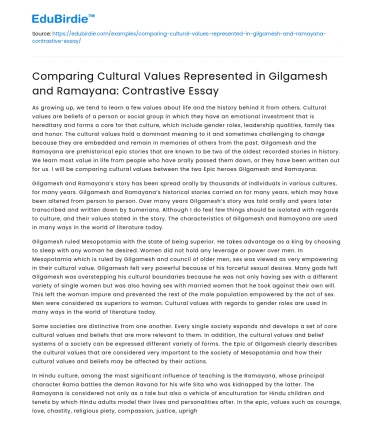As growing up, we tend to learn a few values about life and the history behind it from others. Cultural values are beliefs of a person or social group in which they have an emotional investment that is hereditary and forms a core for that culture, which include gender roles, leadership qualities, family ties and honor. The cultural values hold a dominant meaning to it and sometimes challenging to change because they are embedded and remain in memories of others from the past. Gilgamesh and the Ramayana are prehistorical epic stories that are known to be two of the oldest recorded stories in history. We learn most value in life from people who have orally passed them down, or they have been written out for us. I will be comparing cultural values between the two Epic heroes Gilgamesh and Ramayana.
Gilgamesh and Ramayana’s story has been spread orally by thousands of individuals in various cultures, for many years. Gilgamesh and Ramayana’s historical stories carried on for many years, which may have been altered from person to person. Over many years Gilgamesh’s story was told orally and years later transcribed and written down by Sumerians. Although I do feel few things should be isolated with regards to culture, and their values stated in the story. The characteristics of Gilgamesh and Ramayana are used in many ways in the world of literature today.
Save your time!
We can take care of your essay
- Proper editing and formatting
- Free revision, title page, and bibliography
- Flexible prices and money-back guarantee
Gilgamesh ruled Mesopotamia with the state of being superior. He takes advantage as a king by choosing to sleep with any woman he desired. Women did not hold any leverage or power over men. In Mesopotamia which is ruled by Gilgamesh and council of older men, sex was viewed as very empowering in their cultural value. Gilgamesh felt very powerful because of his forceful sexual desires. Many gods felt Gilgamesh was overstepping his cultural boundaries because he was not only having sex with a different variety of single women but was also having sex with married women that he took against their own will. This left the woman impure and prevented the rest of the male population empowered by the act of sex. Men were considered as superiors to woman. Cultural values with regards to gender roles are used in many ways in the world of literature today.
Some societies are distinctive from one another. Every single society expands and develops a set of core cultural values and beliefs that are more relevant to them. In addition, the cultural values and belief systems of a society can be expressed different variety of forms. The Epic of Gilgamesh clearly describes the cultural values that are considered very important to the society of Mesopotamia and how their cultural values and beliefs may be affected by their actions.
In Hindu culture, among the most significant influence of teaching is the Ramayana, whose principal character Rama battles the demon Ravana for his wife Sita who was kidnapped by the latter. The Ramayana is considered not only as a tale but also a vehicle of enculturation for Hindu children and tenets by which Hindu adults model their lives and personalities after. In the epic, values such as courage, love, chastity, religious piety, compassion, justice, uprightness, and knowledge are exhorted. There is also a clear definition of the qualities that men and women should wish for.
Ramayana provides the human symbol of human perfection between Rama and Sita. The cultural values in gender roles with males were described as honorable, courageous, grateful mind, holy and smart. The cultural values in gender roles are inextricable within the Hindu society. The boundaries between the genders are portrayed a lot differently than The Epic of Gilgamesh.
Women in the Hindu society act as if they are single and not married and should be committed to their marriage. Ramayana establishes the merit of the preservation of close family ties and strong kinship bonds. Marriage is considered to be significantly important as a cultural value. The Hindus value fidelity to one’s partner highly, shown by Sita’s test of fire in which she attempts to burn herself to show her purity to her husband. Sita represents herself as a loving, caring wife that submits herself under the wishes of her husband, which reflects the Hindu tradition of the role of the wife in a marriage.
The Ramayana clearly sets not only the religious prescription in Hindu societies but the entire culture or way of life, as evidenced by the values that it upholds in terms of the political and social aspect in Hindu communities, all of which may be explained through the interdependence of the religious and cultural elements arising from the belief and practice of Hinduism itself: the core concepts of dharma, karma, samsara, and moksha. Therefore, exhorts for an individual and collective aspiration for religious study and civic duty, the karma for righteousness and justice, the samsara for a better life in the next, and the moksha for transcendence. All of those demonstrated in the Ramayana through the presentation of the characters, their actions, and the thoughts that guided these actions, which is hoped to be part of Hindu culture in as much as the epic is a part of it.
Works Cited
- Morosoff, Dorothy. Introduction to Philosophy. McGraw Hill Education, 2014.
- Puchner, Martin, et al. The Norton Anthology of World Literature. 4th ed., vol. 1, W. W. Norton & Company, 2019.
- Stumpf, S. E., & Fieser, J. (2003). Philosophy: History and Problems. Boston: McGraw-Hill.
- The Epic of Gilgamesh. Translated by Benjamin R Foster, W.W. Norton & Company, 2001.
- Velasquez, Manuel. Philosophy: A Text with Readings. Cengage - Wadsworth, 2014.






 Stuck on your essay?
Stuck on your essay?

